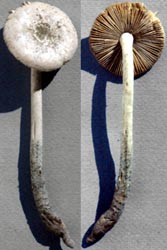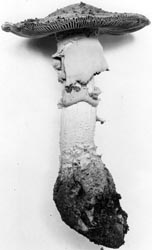|
[ Section Lepidella page. ]
[ Amanita Studies home. ]
[ Keys & Checklist/Picturebooks ] "Bruising Lepidella"
Technical description (t.b.d.) BRIEF DESCRIPTION: Amanita pelioma is named for its strong tendency to bruise blue-green on the bulb and stipe base and, sometimes, on volval remnants in other areas of the fruiting body. Field identification in the U.S. is possible based solely on the staining character; however, a poorly understood amanita with a similar reaction occurs in Mexico. The cap ranges from grayish olive to grayish olivaceous buff to pale buff to pale grayish buff to nearly white and is 40 - 90 mm wide. The gills are usually not white and sometimes are distinctly the color of coffee with milk or colored similarly to the cap or (reportedly) sometimes have a lavender tint; they are free and moderately crowded. Short gills are attenuate. The exannulate stipe is quite slender (90 - 150 x 6 - 12 mm). The spores measure (8.8-) 9.8 - 13.6 (-15.0) x (5.5-) 6.0 - 9.1 (-10.1) Ám and are ellipsoid to elongate (rarely broadly ellipsoid or cylindric) and amyloid. Clamps are absent from bases of basidia. Amanita pelioma is often associated with oak and pine. The species is moderately common in the southeastern U.S. and along the U.S. Gulf Coast. Bas placed A. pelioma in his stirps Cinereoconia (see A. cinereoconia G. F. Atk. var. cinereoconia). -- R. E. Tulloss Photos: R. E. Tulloss (left & right, Mississippi; left-center, Texas); H. C. Beardslee (early 20th C. photo, possibly from North Carolina, gift of Dr. C. Bas)
[ Section Lepidella page. ]
[ Amanita Studies home. ]
[ Keys & Checklist/Picturebooks ] Last changed 17 March 2009. |



